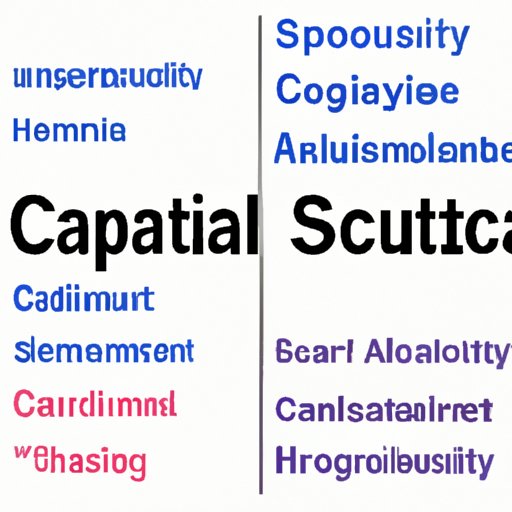Introduction
Cultural capital is a concept developed by French sociologist Pierre Bourdieu to describe the non-financial resources that people can draw upon to gain social or economic advantage. It is a form of power that enables individuals to navigate through society and access opportunities that would otherwise be unavailable. This article will explore the concept of cultural capital in sociology, examining the different types of cultural capital, examples of cultural capital, and its impact on social mobility and stratification.
Types of Cultural Capital
Bourdieu suggested that there are three distinct types of cultural capital – symbolic capital, economic capital, and social capital.
Symbolic Capital
Symbolic capital is made up of intangible assets such as prestige, reputation, and recognition. It involves the accumulation of knowledge, skills, and habits that are valued within a particular social context. According to Bourdieu, “symbolic capital is accumulated through the possession of certain qualifications, awards, achievements, or titles” (Bourdieu, 1984).
Economic Capital
Economic capital refers to tangible assets such as money, property, and investments. It is used to purchase goods and services, which can then be used to generate more wealth. Economic capital can also be used to gain access to resources, such as higher education and better job opportunities.
Social Capital
Social capital is composed of relationships, networks, and contacts that enable individuals to access resources and opportunities. It is based on trust, reciprocity, and mutual obligation, and is often used to gain access to jobs, housing, education, and other forms of social and economic capital. According to Robert Putnam, “social capital is essentially about trust, norms and networks” (Putnam, 2000).
Examples of Cultural Capital
Cultural capital can manifest itself in various ways, including education, language, and class status.
Education
Education is one of the most important forms of cultural capital. It provides individuals with the knowledge and skills needed to pursue a successful career, as well as access to networks and resources. Studies have shown that those with higher levels of educational attainment tend to have higher incomes, better job prospects, and greater social mobility (Erikson & Jonsson, 1996).
Language
Language is another form of cultural capital. Those who speak more than one language have an advantage when it comes to accessing resources, as they are able to communicate effectively with a wider range of people. In addition, bilingualism has been linked to higher levels of cognitive development and improved academic performance (Kroll & Bialystok, 2013).
Class Status
Class status can also be considered a form of cultural capital. Those from higher social classes tend to have access to greater financial resources, which can be used to purchase goods and services, as well as access to exclusive networks and opportunities. In addition, class status can influence social standing and perceptions of worth (Lareau, 2003).

Impact of Cultural Capital on Social Mobility
Cultural capital can have a significant impact on social mobility. Individuals with greater levels of cultural capital are more likely to have access to resources and opportunities that can help them move up the social ladder.
Access to Opportunities
Those with higher levels of cultural capital are more likely to have access to resources that can open up new opportunities, such as higher education and better job prospects. For example, studies have shown that those from higher social classes are more likely to attend prestigious universities and have access to exclusive networks (Shavit & Blossfeld, 1993).
Ability to Accumulate Wealth
Cultural capital can also give individuals an advantage when it comes to accumulating wealth. Those with higher levels of cultural capital are more likely to have access to financial resources, which can be used to purchase goods and services, as well as invest in stocks and bonds. In addition, those with higher levels of cultural capital are more likely to have access to exclusive networks that can help them accumulate wealth (Akerlof & Kranton, 2000).
Influence on Social Standing
Cultural capital can also have an impact on social standing. Those with higher levels of cultural capital are more likely to be seen as prestigious and influential, which can lead to increased respect and admiration from others. This can be beneficial for those looking to climb the social ladder, as it can open up new opportunities and networks (Bourdieu, 1986).

Exploring the Relationship between Cultural Capital and Education
Education is one of the most important forms of cultural capital, and has a significant impact on social mobility. It provides individuals with the knowledge and skills needed to succeed in their chosen field, as well as access to networks and resources.
Unpacking the Educational System
The educational system is designed to provide equal access to opportunities, regardless of socio-economic background. However, studies have shown that those from higher social classes are more likely to attend prestigious universities, and have access to exclusive networks and resources (Shavit & Blossfeld, 1993). This suggests that there is an unequal distribution of cultural capital within the educational system, which gives those from higher social classes an advantage when it comes to pursuing success.
Cultural Capital as a Source of Advantage
Those with higher levels of cultural capital are more likely to have access to resources that can give them an edge. This includes access to higher education, exclusive networks, and financial resources. These resources can provide individuals with the tools they need to succeed, and can give them an advantage over those from lower social classes (Lareau, 2003).
Disadvantages of Low Cultural Capital
Those from lower social classes often lack access to resources that can help them succeed. This can include access to higher education, exclusive networks, and financial resources. Without these resources, individuals from lower social classes may find it difficult to compete with those from higher social classes, leading to a widening of the gap between the haves and the have-nots (Akerlof & Kranton, 2000).
The Role of Cultural Capital in Social Stratification
Cultural capital can have a significant impact on social stratification. Those with higher levels of cultural capital are more likely to have access to resources and opportunities that can help them move up the social ladder, while those with lower levels of cultural capital may find it difficult to access the same resources. This can lead to a widening of the gap between the haves and the have-nots, and can contribute to the perpetuation of social stratification.
Unequal Access to Resources
Studies have shown that those from higher social classes tend to have greater access to resources, such as higher education and exclusive networks. This can give them an advantage when it comes to pursuing success, and can lead to an unequal distribution of resources within society (Shavit & Blossfeld, 1993).
Effects on Social Class
Cultural capital can also have an effect on social class. Those with higher levels of cultural capital are more likely to be seen as prestigious and influential, which can lead to increased respect and admiration from others. This can give them an advantage when it comes to climbing the social ladder, as they are more likely to have access to resources, networks, and opportunities that can help them succeed (Bourdieu, 1986).
Intergenerational Processes
Cultural capital is often passed down through generations, creating a cycle of privilege and disadvantage. Those from higher social classes are more likely to have access to resources, such as higher education and exclusive networks, which can be passed down to their children. This can create an intergenerational process of inequality, as those from lower social classes may find it difficult to access the same resources (Lareau, 2003).
Conclusion
This article has explored the concept of cultural capital in sociology. It has examined the different types of cultural capital, examples of cultural capital, and its impact on social mobility and stratification. The findings suggest that cultural capital can have a significant impact on social mobility, as those with higher levels of cultural capital are more likely to have access to resources and opportunities that can help them move up the social ladder. In addition, cultural capital can have an effect on social stratification, as those with lower levels of cultural capital may find it difficult to access the same resources. Further exploration is needed to understand the full implications of cultural capital on social mobility and stratification.
(Note: Is this article not meeting your expectations? Do you have knowledge or insights to share? Unlock new opportunities and expand your reach by joining our authors team. Click Registration to join us and share your expertise with our readers.)
